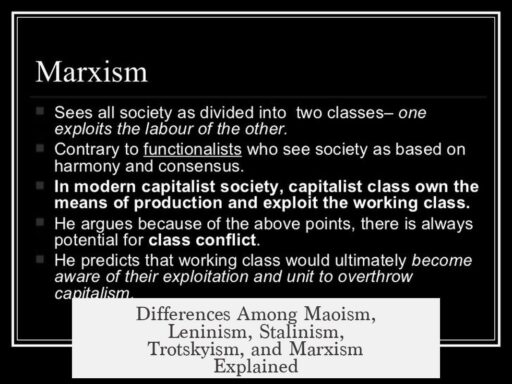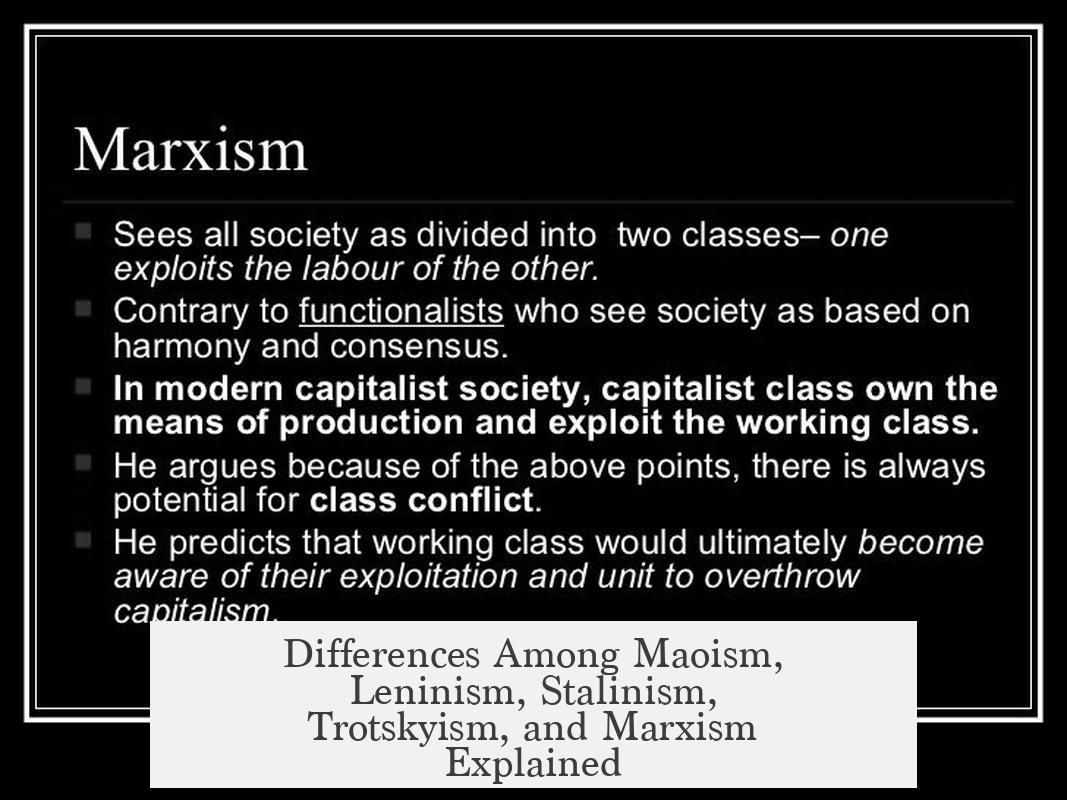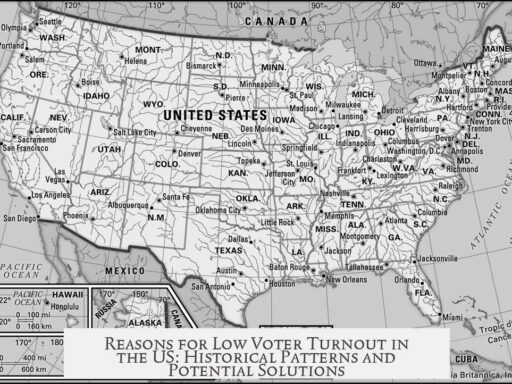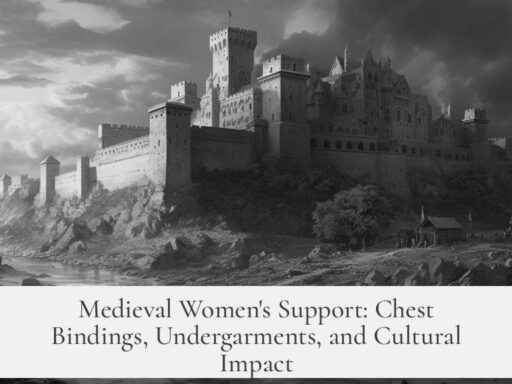The main differences between Maoism, Leninism, Stalinism, Trotskyism, and Marxism lie in their interpretations of class struggle, revolutionary strategy, leadership structure, and approach to internationalism. Each ideology builds on or reacts to Marxism, adapting it to different historical and social contexts.
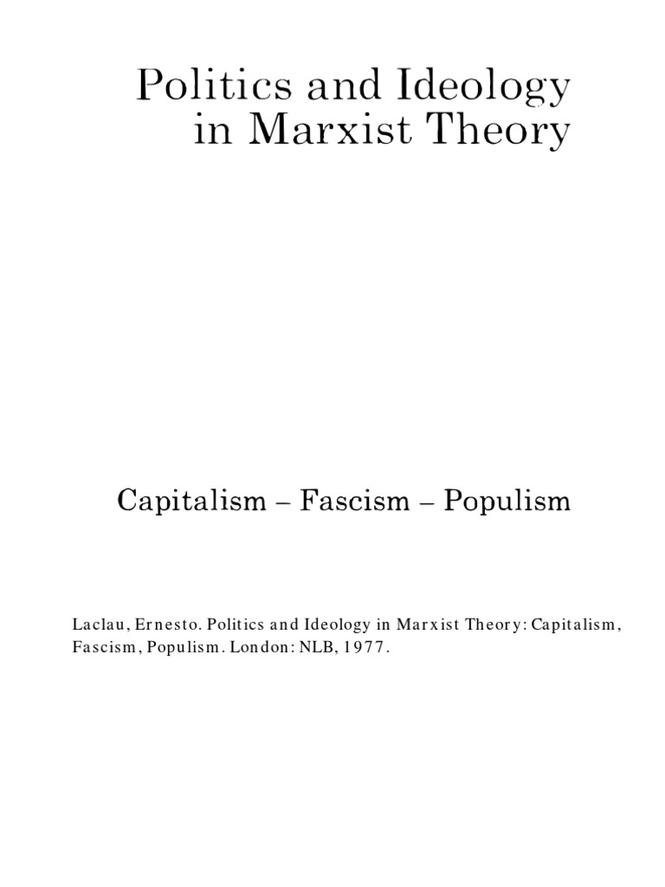
Marxism originates from Karl Marx’s 19th-century analysis of history as a series of class struggles. It focuses on capitalism’s inherent conflicts between the bourgeoisie (capitalist class) and the proletariat (working class). Marx argues that capitalism creates economic instability and exploitation, inevitably provoking the working class to overthrow the capitalist system through revolution. The ultimate goal is a classless, stateless society where workers control production. Marx also emphasizes that the revolution must be worldwide to succeed, as workers share common interests beyond nationality or ethnicity.
Leninism, developed by Vladimir Lenin, extends Marxism by addressing political organization for revolution. Lenin introduces the concept of a vanguard party, a disciplined, hierarchical group that leads the proletariat. This party suppresses dissent and rival socialist factions to maintain unity and strength. Leninism shifts the focus from purely economic analysis to active revolutionary leadership and practical control. It also introduces Marxist critiques of colonialism, adapting Marxism to the realities of late imperialist capitalism. Leninism thus lays the groundwork for one-party states where the party dominates all aspects of governance.
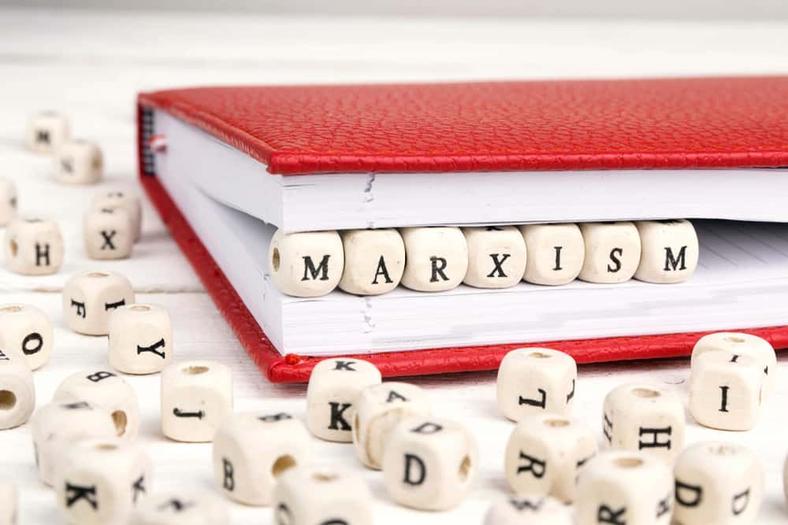
Stalinism evolves from Leninism under Joseph Stalin’s leadership with distinct characteristics. It abandons Marxist internationalism in favor of “socialism in one country,” prioritizing the Soviet Union’s development and consolidation. Stalinism pushes rapid industrialization and authoritarian control, often at a brutal human cost, including purges and repression against perceived enemies. Stalinism merges some authoritarian elements inspired by fascism, emphasizing political control over workers’ rights or egalitarian goals. It is often associated with oppressive regimes that justify harsh tactics to maintain state power.
Trotskyism opposes Stalinism’s authoritarianism and nationalism. Leon Trotsky, once Lenin’s ally, criticizes Stalin’s repression and his abandonment of international revolution. Trotskyism insists that true socialism requires global revolution and permanent revolution, rejecting the idea that socialism can succeed in a single country alone. After Trotsky is exiled and assassinated by Stalin’s orders, his followers continue advocating for internationalism and democratic socialist principles opposed to Stalinist repression.
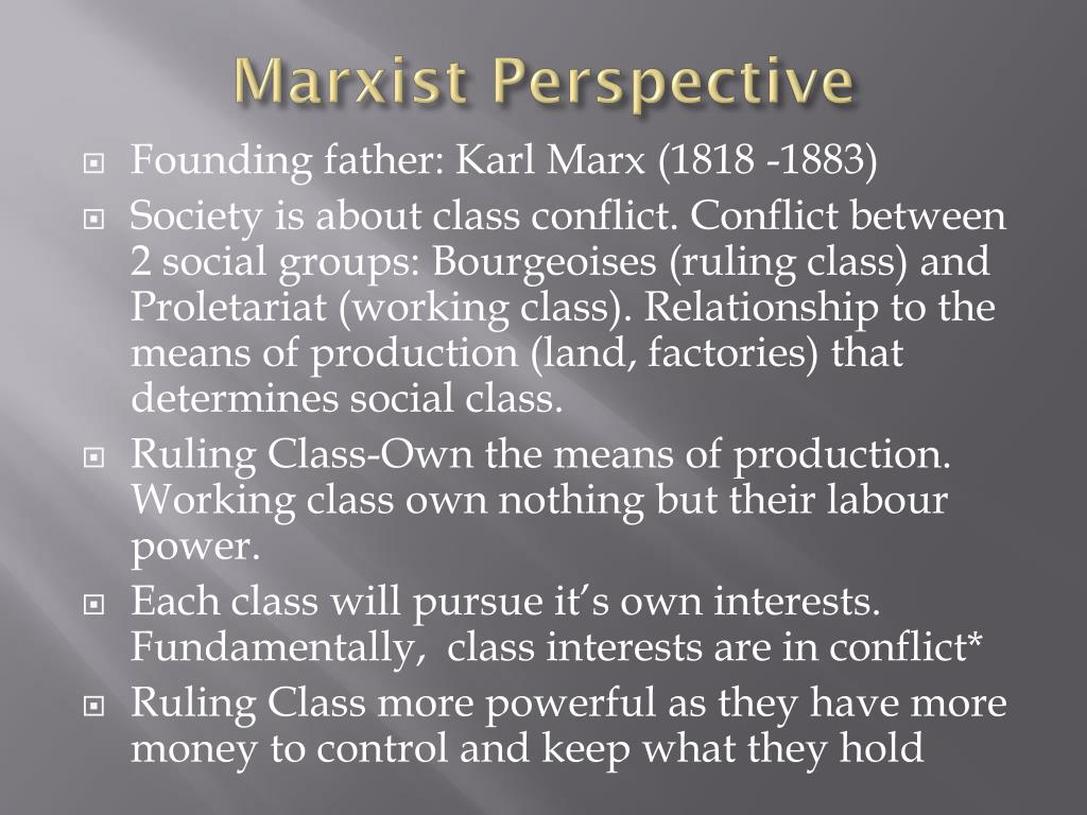
Maoism, articulated by Mao Zedong, diverges significantly by redefining the revolutionary class. Where Marx prioritized the urban proletariat, Mao focuses on rural peasants as the primary revolutionary force, especially in colonized and agrarian societies. Maoism stresses that peasants must rise against imperialism, sparking not only national liberation but also global transformation. This makes Maoism a form of rural Marxism tailored to Third World conditions. Mao’s rule is also marked by mass violence and strong state control, leading to widespread repression and social upheaval.
| Ideology | Core Strategy | Class Focus | Political Structure | View on Revolution | Notable Characteristics |
|---|---|---|---|---|---|
| Marxism | Worldwide proletarian revolution | Urban working class (proletariat) | Collective class action, no party specified | International, against capitalism globally | Classless, stateless society goal |
| Leninism | Vanguard party leading proletariat | Urban working class plus party elite | Hierarchical, militant one-party state | International revolution with party leadership | Suppresses dissent, Marxist anti-colonialism |
| Stalinism | Socialism in one country, authoritarian | Workers but subordinated to state control | Authoritarian, centralized dictatorship | Focus on national consolidation, anti-internationalism | Mass repression, purges, rapid industrialization |
| Trotskyism | Permanent international revolution | Proletariat, global working class solidarity | Opposes authoritarianism, supports democratic socialist governance | Internationalist, rejects Stalinist nationalism | Criticizes repression and bureaucracy |
| Maoism | Peasant-led revolution in agrarian societies | Rural peasants | Authoritarian state, one-party rule | National liberation triggering world revolution | Rural Marxism, associated with mass killings |
In practice, these ideologies vary in how they have been implemented and perceived globally. Marxism serves as the theoretical foundation. Leninism introduces a politically savvy vanguard leadership. Stalinism emphasizes strict control and national focus with harsh repression, moving away from Marx’s internationalism. Trotskyism maintains the original international revolutionary spirit while opposing Stalinism’s methods. Maoism adapts Marxism to rural, colonized nations, emphasizing peasants as the engine of change but also involving significant oppression.
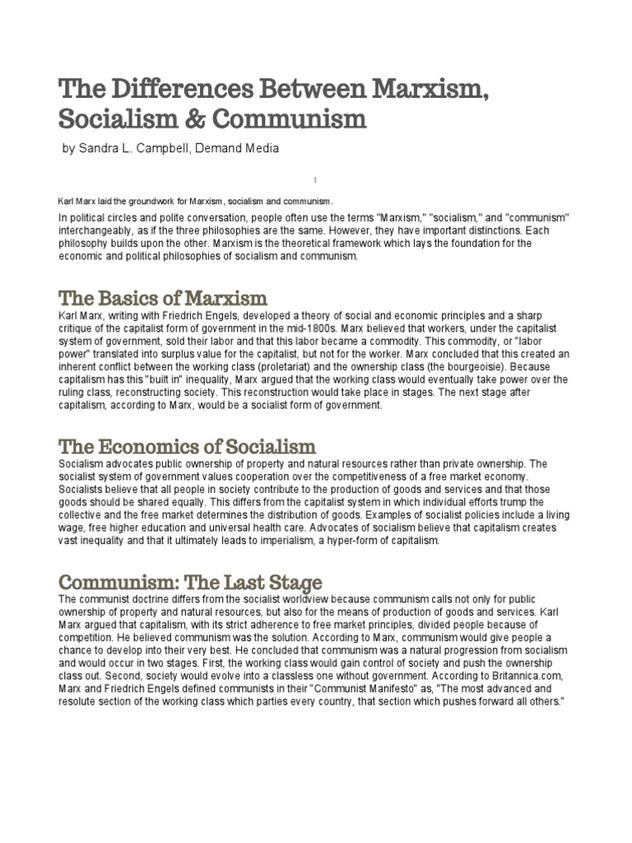
The distinctions can be summarized as follows:
- Marxism highlights class struggle and the inevitability of a global proletarian revolution.
- Leninism adds the need for a disciplined vanguard party to lead the revolution and political organization.
- Stalinism replaces international revolution with socialism in one country, paired with authoritarian control and repression.
- Trotskyism counters Stalinism by supporting international revolution and opposing political repression.
- Maoism shifts focus from urban workers to rural peasants and combines national liberation with global revolutionary aims.
Each ideology reflects a strategic and theoretical adaptation of Marxism to distinct historical settings and political objectives.
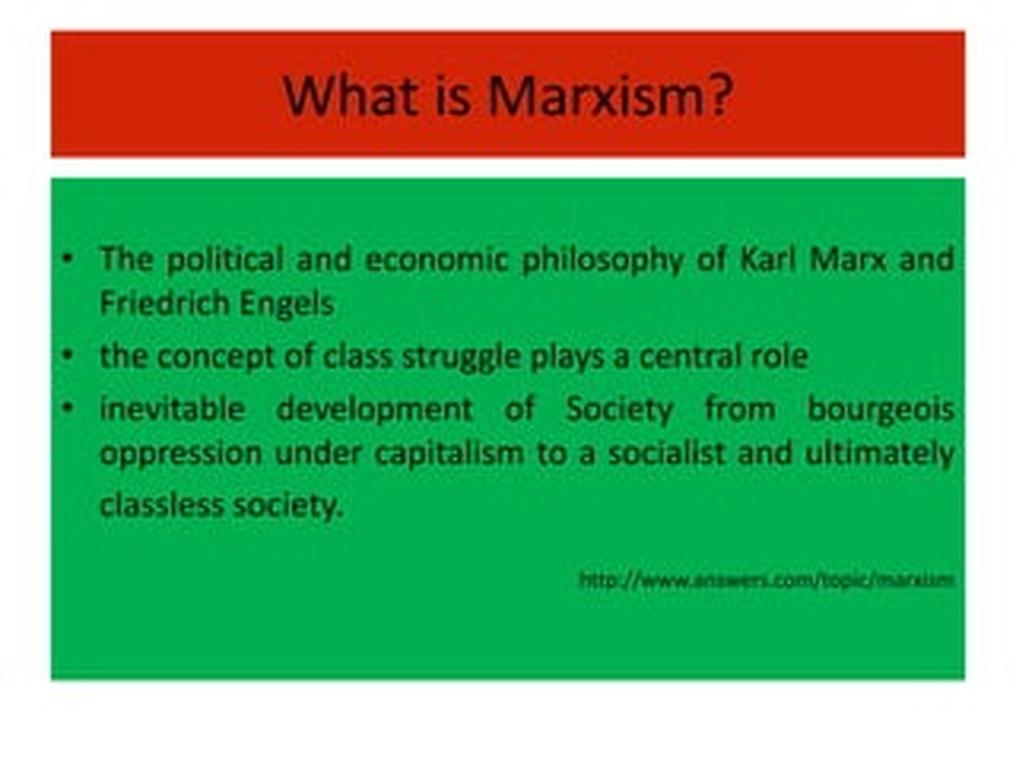
- Marxism centers on global working-class revolution and capitalism’s overthrow.
- Leninism introduces a vanguard party to direct revolution and state power.
- Stalinism enforces authoritarian control focused on one nation and industrial growth.
- Trotskyism promotes continuous international revolution and denounces Stalinist repression.
- Maoism prioritizes peasant-led revolution linked to anti-imperialist struggles.
What is the difference between: Maoism, Leninism, Stalinism, Trotskyism, and Marxism?
Understanding the differences between Maoism, Leninism, Stalinism, Trotskyism, and Marxism can feel like trying to decode a secret revolutionary recipe with too many cooks. But don’t worry, this straightforward guide breaks it down clearly and with a sprinkle of humor. At their core, these ideologies share a belief in the class struggle and the goal of a socialist society, but they differ sharply in their methods, focus, and practical outcomes.
Let’s dive in and unpack the distinct flavors of each.
Marxism: The Grandparent of Revolutionary Ideas
Marxism, named after the 19th-century thinker Karl Marx, is the bedrock of these ideologies. It proposes that history is defined by class struggle. The capitalist class (bourgeoisie) exploits workers, leading to inevitable conflict and revolution. The ultimate goal? A stateless, classless society where workers run the show worldwide.
Think of Marxism as the blueprint. Karl Marx spotted patterns in history, such as how the capitalist class triumphed over aristocrats during the Renaissance, and predicted that workers will overthrow capitalism—either through ballots or battles. This vision hinges on all workers globally uniting against their common economic enemies, no matter nationality or ethnicity.
His critique pointed out capitalism’s brutal boom and bust cycles and the relentless need for underpaid or unemployed labor. Marx believed the system’s internal tensions would eventually prompt its collapse, clearing the way for socialist revolution.
Leninism: Marxism Meets Political Machiavellianism
Enter Vladimir Lenin, who took Marx’s ideas and added a dash of political strategy to create Leninism. While Marx focused on economic forces, Lenin emphasized the necessity of a disciplined, hierarchical “vanguard party” to lead the working class.
This vanguard party isn’t your typical democratic assembly. It’s tightly organized, intolerant of dissent, and suppresses rival socialist factions. Lenin believed only such a militant leadership could shepherd the workers through revolution and beyond.
He also developed Marxist theories about colonialism, highlighting the global oppression in imperialist systems. But perhaps Leninism’s defining legacy is its association with one-party rule. Where Marx envisioned a more open-ended class struggle, Lenin’s model morphed social revolution into authoritarian control—a clever political move that has plagued many subsequent communist regimes.
Stalinism: The Iron Fist with a Red Glove
Joseph Stalin took Leninism and added his own controversial twist, resulting in Stalinism. Here, rapid industrialization and absolute political control came first—worker rights and egalitarian ideals took a backseat.
Notably, Stalin abandoned the Marxist-Leninist internationalism—the belief in worldwide revolution. Instead, he promoted “socialism in one country.” This was a big pivot: the Soviet Union would focus inward, shoring up its power rather than aggressively exporting revolution worldwide.
But Stalinism’s legacy is also marked by fear, repression, and bloodshed. The purges, mass arrests, and executions literally killed millions. This stark authoritarianism led many to equate Stalinism broadly with any oppressive, leftist dictatorship.
Trotskyism: The Internationalist Rebel
Leon Trotsky was a Lenin ally turned Stalin critic. Opposing the idea of “socialism in one country,” Trotsky championed permanent revolution—continuous, worldwide uprising of workers.
During his exile, Trotsky vocally condemned Stalin’s repressions, which didn’t earn him any friends in the Kremlin. Stalin orchestrated Trotsky’s assassination, turning the power struggle deadly.
Trotsky’s followers, known as Trotskyists, reject Stalinism’s authoritarianism and isolationism, advocating instead for global revolution and democratic socialism within the workers’ movement.
Maoism: When the Peasants Take the Stage
Mao Zedong adapted Marxism to China’s unique conditions. Unlike Marx, who put his revolutionary faith in urban industrial workers, Mao argued that China’s agrarian peasants were the true revolutionary force.
This reframing was key: Maoism centers on rural peasants rather than factory workers. It appealed to colonized, rural societies where peasants formed the majority. The logic? Peasants would rise first against imperialism, sparking a wider global revolution.
This “rural Marxism” included mass mobilizations and sometimes brutal coercive campaigns. Mao’s rule is remembered both for its revolutionary fervor and its association with mass killings and harsh political repression.
Putting It All Together: A Quick Comparison Table
| Ideology | Key Focus | Revolutionary Class | Political Approach | International Outlook | Notable Features |
|---|---|---|---|---|---|
| Marxism | Class struggle, economic forces | Urban working class | No specific party model | Worldwide revolution | Stateless, classless society goal |
| Leninism | Political organization | Urban working class | Vanguard party, one party rule | Worldwide revolution + colonialism critique | Suppression of dissent |
| Stalinism | Industrialization, authoritarian control | Urban working class (repressed) | One party dictatorship | Socialism in one country | Mass repression and purges |
| Trotskyism | Permanent world revolution | Urban working class | Opposed Stalinist dictatorship | Internationalism | Critique of Stalinism |
| Maoism | Agrarian revolution | Peasants | Rural-oriented mass mobilization | Third world-led revolution | Mass killings, repressive policies |
Why Does This Matter Today?
Understanding these distinctions isn’t just academic hair-splitting. These ideologies shaped major events and governments that affect global politics, economics, and social movements even now. For activists, historians, or curious minds, knowing their differences clarifies how ideas translate into policies and power.
Plus, these debates still fuel political discourse worldwide. Have you ever wondered why some revolutions emphasize peasants instead of urban workers? Or why some socialist governments are one-party states while others embrace broader political participation? The answer often lies in these ideological splits.
Final Thoughts
So, what sets these theories apart? Marxism lays the foundation with class struggle and universal worker revolution. Leninism adds a disciplined, militant party to lead that revolution. Stalinism shifts focus inward with ruthless control and prioritizes national development. Trotskyism fights back against Stalin’s authoritarian turn by advocating for ongoing global revolution. Maoism breaks from tradition by placing rural peasants at the center, aiming at colonized world liberation.
Perhaps the most surprising takeaway is how these ideas, born from a commitment to equality, often ended in very different realities—sometimes tragic, sometimes transformative.
Curious to explore a specific ideology even deeper? Or wondering how these ideas influence contemporary politics? Let’s keep the conversation going!
